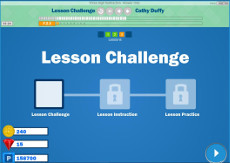iLearn Math is an online system for math covering grades one through nine, and Algebra 1 for ninth grade. This is an adaptive system that continually adjusts to the student’s performance, eliminating lessons if children are able to pass “challenges” before a lesson begins.
When you sign up, you choose a child’s grade level. The first thing the student does is take a placement test that begins testing a grade level below his or her stated level. Next, the program presents some challenges to further fine-tune the student's placement.
Then it selects an appropriate “chapter” in which to begin. Still, a Chapter Challenge before each chapter begins says, “Score 85% or higher and you will skip over all of the lessons in this chapter.” If the student scores lower than 85%, the student will work through lessons, chapter practice, and tests.
However, even within the chapter, the student begins each lesson with a Lesson Challenge” that, if passed, allows the student to skip the lesson instruction and practice and move on to the next. Lessons are presented in small increments, with each lesson covering only one skill. This makes it possible for the program to accurately identify areas already mastered.
You can see how efficient this is. Students need not waste time on materials they’ve already mastered.
Lesson instruction is presented with voice-overs and problems shown on the screen. At least two or three examples are worked out after the instruction. Then students practice problem solving. Instruction is very straightforward without a lot of conceptual development or applications.
Occasionally, the program uses graphic images or animations to show what is happening—more so at the early grade levels. For example, it uses arrays of squares to demonstrate basic addition and subtraction. It also uses arrays of squares for solving multiplication problems that require carrying. The program has its own tools that are used in the demonstration and then also used by the student to solve problems. While this graphic tool makes sense, I found it awkward to use; students can skip it and solve the problem on their own if they prefer, just entering in the correct answer. This is also true for borrowing and carrying problems. Graphic tools are there for the student to use to show detailed steps, but they can skip them if they want.
There is no cumulative review, although unit tests cover a number of chapters, essentially challenging students to remember what they might have learned months ago depending upon the size of the unit. Word problems and practical applications are also lacking in iLearn Math. Those who want to supplement with word problems might try using something like Challenge Math.
Students earn “coins” and “gems” as they complete activities. These can be used to “purchase” avatars, background screens, stickers, and feedback sounds to personalize their interface. These might motivate some students while others might ignore them.
The scope and sequence is fairly advanced. For example, factors and prime numbers are taught in fourth grade and the concept of functions is introduced at the eighth-grade level.
iLearn requires a headset or speakers and a mouse. It will run on Windows or Mac systems as well as on the Google Chromebook, but it does not appear to function on most tablets or on phones.
Parents can log in with their child’s user name and password to see reports on activity, progress, grades, etc. Students can access these same reports, but they can't alter them. Parents receive email notifications when students complete elements of the program, and they can choose the frequency for these notifications as well as the kinds of activities for which they want notification.
iLearn Math seems best for bright students who want to get through math as quickly as they can and who don’t need concepts explained in a variety of ways to grasp them.








